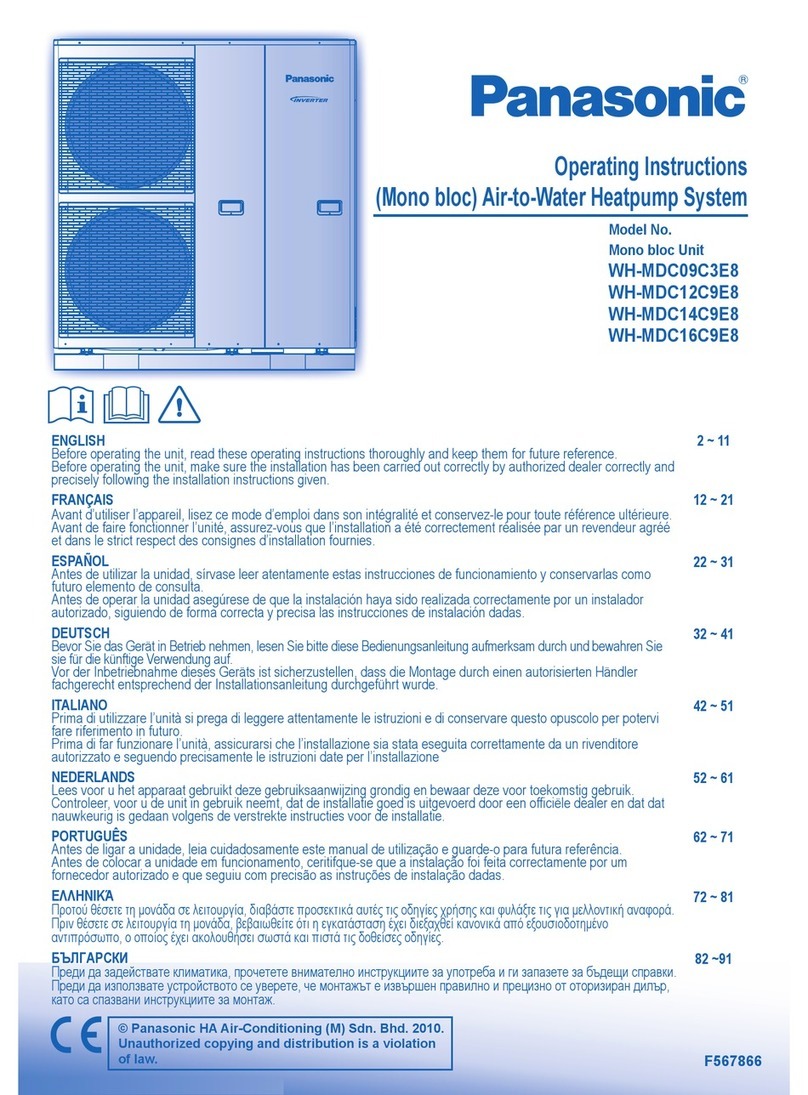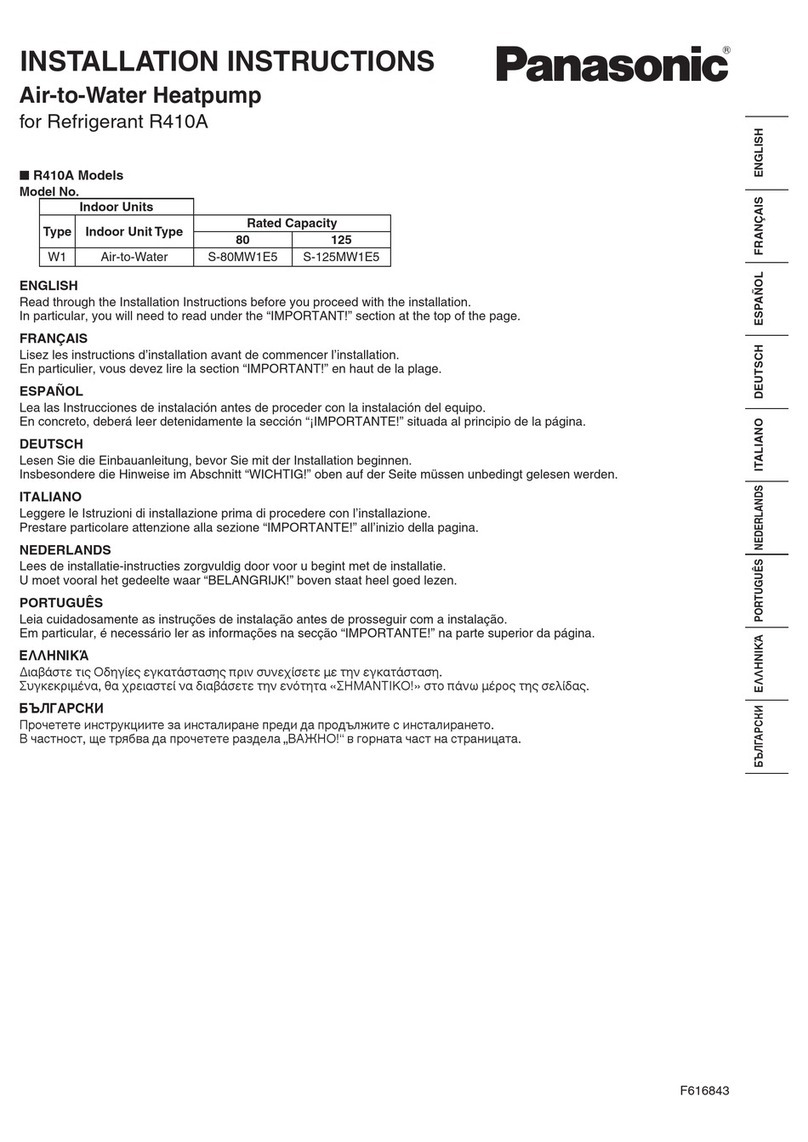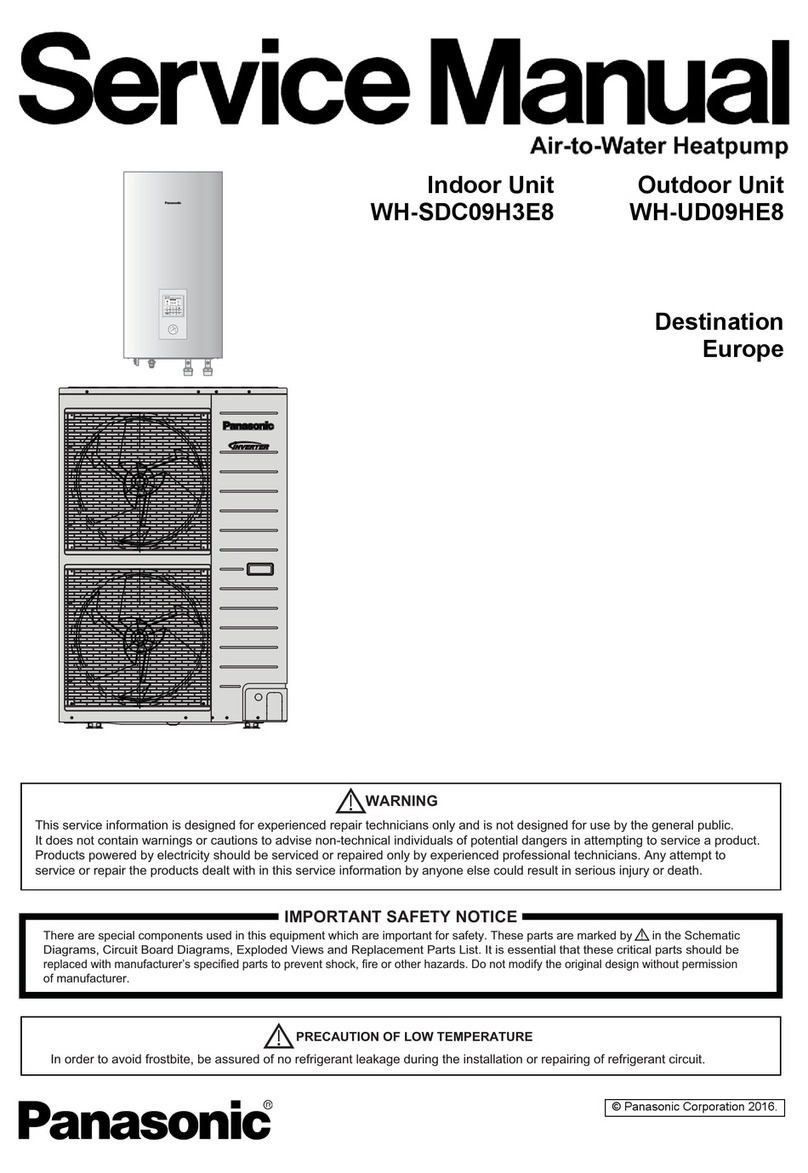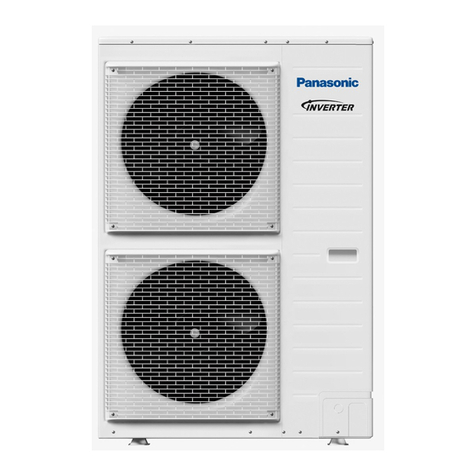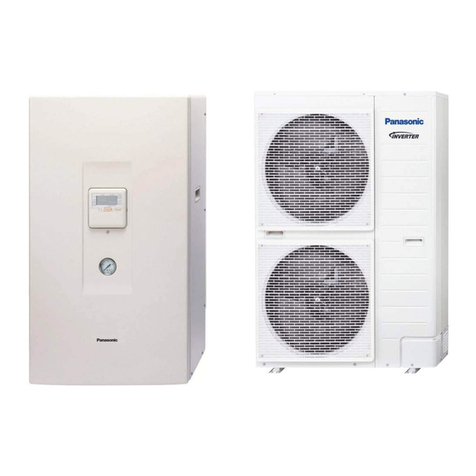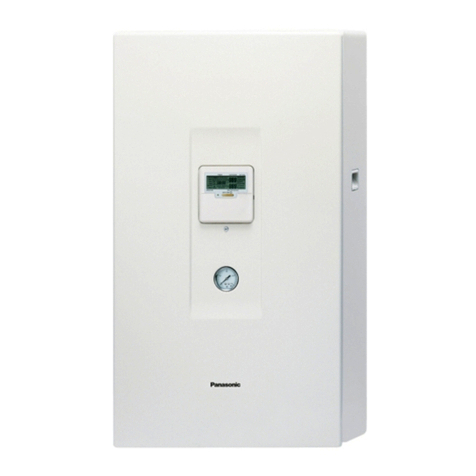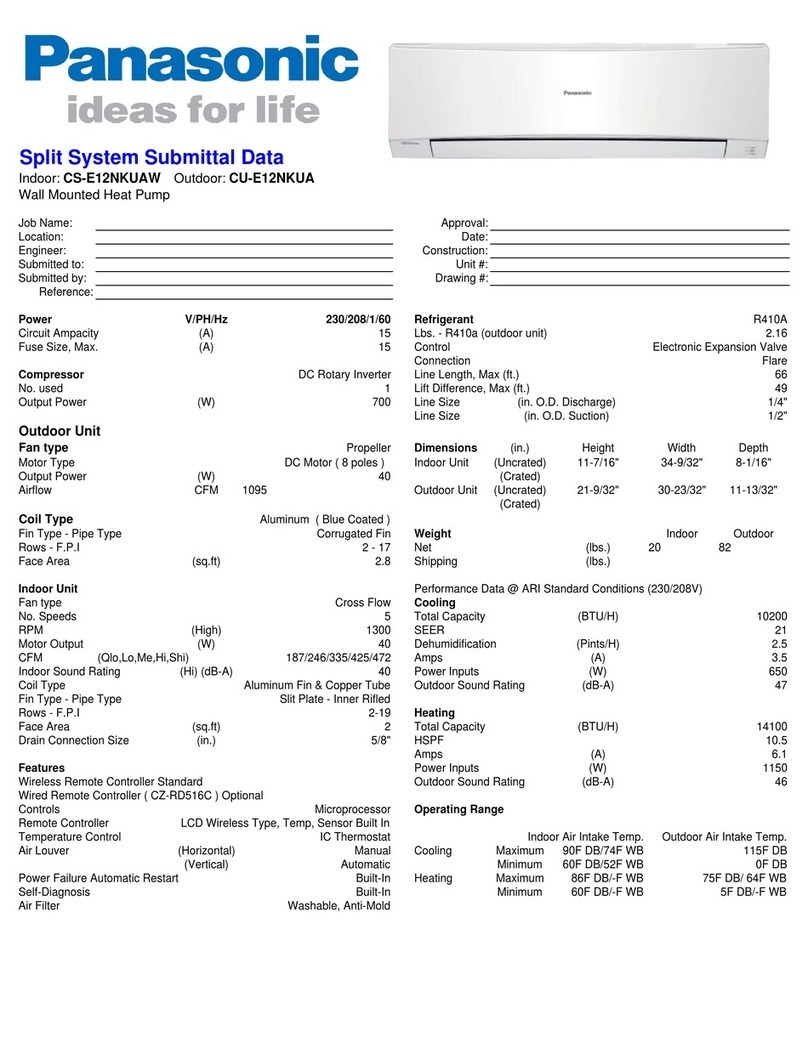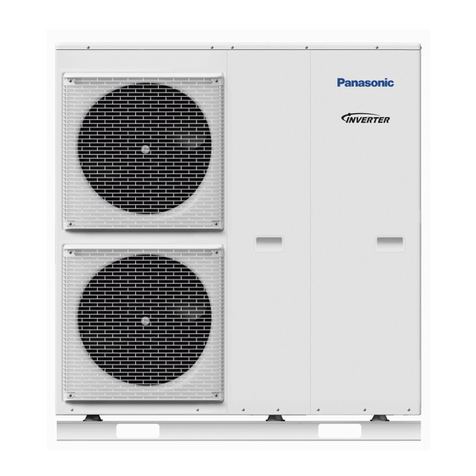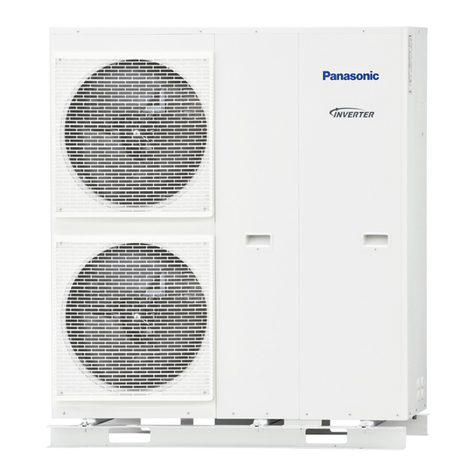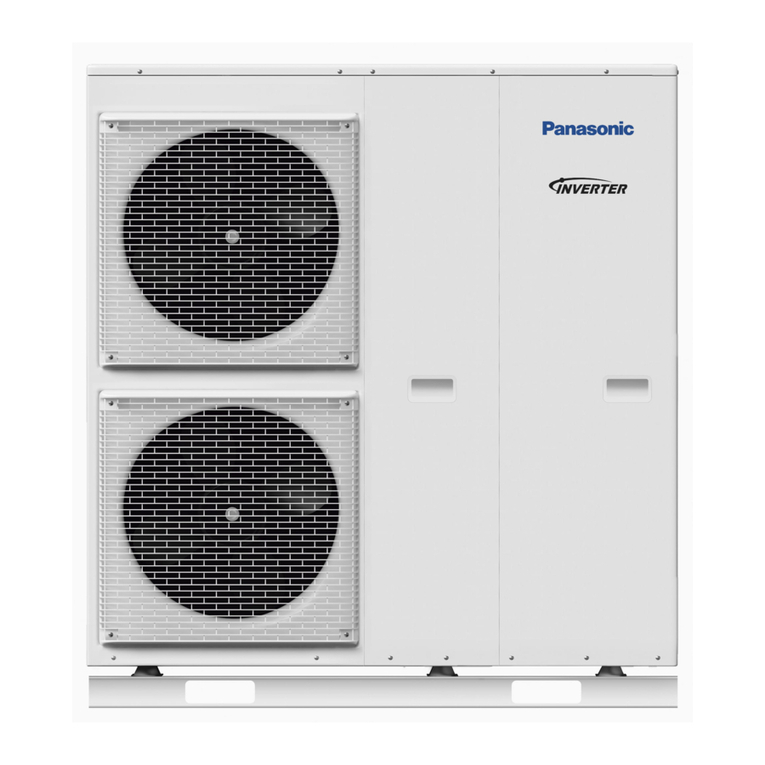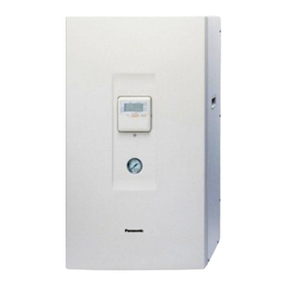8. Removal and evacuation
• When breaking into the refrigerant circuit to make repairs – or for any other purpose – conventional procedures shall be used.
However, it is important that best practice is followed since flammability is a consideration.
The following procedure shall be adhered to:
• remove refrigerant -> • purge the circuit with inert gas -> • evacuate -> • purge with inert gas -> • open the circuit by cutting or brazing
• The refrigerant charge shall be recovered into the correct recovery cylinders.
• The system shall be purged with OFN to render the appliances safe. (remark: OFN = oxygen free nitrogen, type of inert gas)
• This process may need to be repeated several times.
• Compressed air or oxygen shall not be used for this task.
• Purging shall be achieved by breaking the vacuum in the system with OFN and continuing to fill until the working pressure is achieved, then venting to atmosphere, and finally pulling down to a vacuum.
• This process shall be repeated until no refrigerant is within the system.
• When the final OFN charge is used, the system shall be vented down to atmospheric pressure to enable work to take place.
• This operation is absolutely vital if brazing operations on the pipe work are to take place.
• Ensure that the outlet for the vacuum pump is not close to any potential ignition sources and there is ventilation available.
9. Charging procedures
• In addition to conventional charging procedures, the following requirements shall be followed.
- Ensure that contamination of different refrigerants does not occur when using charging equipment.
- Hoses or lines shall be as short as possible to minimize the amount of refrigerant contained in them.
- Cylinders shall be kept in an appropriate position according to the instructions.
- Ensure that the refrigerating system is earthed prior to charging the system with refrigerant.
- Label the system when charging is complete (if not already).
- Extreme care shall be taken not to over fill the refrigerating system.
• Prior to recharging the system it shall be pressure tested with OFN (refer to #7).
• The system shall be leak tested on completion of charging but prior to commissioning.
• A follow up leak test shall be carried out prior to leaving the site.
• Electrostatic charge may accumulate and create a hazardous condition when charging and discharging the refrigerant.
To avoid fire or explosion, dissipate static electricity during transfer by grounding and bonding containers and equipment before charging/discharging.
10.
Decommissioning
• Before carrying out this procedure, it is essential that the technician is completely familiar with the equipment and all its details.
• It is recommended good practice that all refrigerants are recovered safely.
• Prior to the task being carried out, an oil and refrigerant sample shall be taken in case analysis is required prior to re-use of recovered refrigerant.
• It is essential that electrical power is available before the task is commenced.
a) Become familiar with the equipment and its operation.
b) Isolate system electrically.
c) Before attempting the procedure ensure that:
f) Make sure that cylinder is situated on the scales before recovery takes place.
g) Start the recovery machine and operate in accordance with instructions.
h) Do not over fill cylinders. (No more than 80 % volume liquid charge).
i) Do not exceed the maximum working pressure of the cylinder, even temporarily.
j) When the cylinders have been filled correctly and the process completed, make sure that the
cylinders and the equipment are removed from site promptly and all isolation valves on the equipment
are closed off.
k) Recovered refrigerant shall not be charged into another refrigerating system unless it has been
cleaned and checked.
• mechanical handling equipment is available, if required, for handling refrigerant cylinders;
• all personal protective equipment is available and being used correctly;
• the recovery process is supervised at all times by a competent person;
• recovery equipment and cylinders conform to the appropriate standards.
d) Pump down refrigerant system, if possible.
e) If a vacuum is not possible, make a manifold so that refrigerant can be removed from various
parts of the system.
• Electrostatic charge may accumulate and create a hazardous condition when charging or discharging the refrigerant.
To avoid fire or explosion, dissipate static electricity during transfer by grounding and bonding containers and equipment before charging/discharging.
11.
Labelling
• Equipment shall be labelled stating that it has been de-commissioned and emptied of refrigerant.
• The label shall be dated and signed.
• Ensure that there are labels on the equipment stating the equipment contains flammable refrigerant.
12.
Recovery
• When removing refrigerant from a system, either for servicing or decommissioning, it is recommended good practice that all refrigerants are removed safely.
• When transferring refrigerant into cylinders, ensure that only appropriate refrigerant recovery cylinders are employed.
• Ensure that the correct number of cylinders for holding the total system charge are available.
• All cylinders to be used are designated for the recovered refrigerant and labelled for that refrigerant (i.e. special cylinders for the recovery of refrigerant).
• Cylinders shall be complete with pressure relief valve and associated shut-off valves in good working order.
• Recovery cylinders are evacuated and, if possible, cooled before recovery occurs.
• The recovery equipment shall be in good working order with a set of instructions concerning the equipment that is at hand and shall be suitable for the recovery of flammable refrigerants.
• In addition, a set of calibrated weighing scales shall be available and in good working order.
• Hoses shall be complete with leak-free disconnect couplings and in good condition.
• Before using the recovery machine, check that it is in satisfactory working order, has been properly maintained and that any associated electrical components are sealed to prevent ignition in the event of a
refrigerant release.
Consult manufacturer if in doubt.
• The recovered refrigerant shall be returned to the refrigerant supplier in the correct recovery cylinder, and the relevant Waste Transfer Note arranged.
• Do not mix refrigerants in recovery units and especially not in cylinders.
• If compressors or compressor oils are to be removed, ensure that they have been evacuated to an acceptable level to make certain that flammable refrigerant does not remain within the lubricant.
• The evacuation process shall be carried out prior to returning the compressor to the suppliers.
• Only electric heating to the compressor body shall be employed to accelerate this process.
• When oil is drained from a system, it shall be carried out safely.
Handling of Mono bloc unit
Mono bloc unit is a large and heavy apparatus. The handling of the unit only to be done
by lifting tools with slings.These slings can be fitted into sleeves at the unit’s base frame.
Attached Accessories
No. Accessories part Qty.
1Drain elbow 1
2Rubber cap 8
3
Remote controller
1
Optional Accessory
No. Accessories part Qty.
4Optional PCB (CZ-NS4P) 1
5Base Pan Heater (CZ-NE3P) 1
6Network Adaptor (CZ-TAW1) 1
7Network Adaptor Cable (CZ-TAW1-CBL) 1
Field Supply Accessories (Optional)
No. Part Model Specification Maker
i 2-way valve kit Electromotoric Actuator SFA21/18 AC230V Siemens
2-port Valve VVI46/25 - Siemens
ii 3-way valve kit Electromotoric Actuator SFA21/18 AC230V Siemens
3-port Valve VXI46/25 - Siemens
iii Room thermostat Wired PAW-A2W-RTWIRED AC230V -
Wireless PAW-A2W-RTWIRELESS
iv Mixing valve - 167032 AC230V Caleffi
v Pump - Yonos 25/6 AC230V Wilo
vi Buffer tank sensor - PAW-A2W-TSBU - -
vii Outdoor sensor - PAW-A2W-TSOD - -
viii Zone water sensor - PAW-A2W-TSHC - -
ix Zone room sensor - PAW-A2W-TSRT - -
x Solar sensor - PAW-A2W-TSSO - -
It is recommended to purchase the field supply accessories listed in above table.
SAFETY PRECAUTIONS
•
Read the following “SAFETY PRECAUTIONS” carefully before installation of (Mono bloc) Air-to-Water Heatpump system (hereafter referred to as “Mono bloc unit”).
•
Electrical works and water installation works must be done by licensed electrician and licensed water system installer respectively. Be sure to use the correct rating and
main circuit for the model to be installed.
•
The caution items stated here must be followed because these important contents are related to safety. The meaning of each indication used is as below.
Incorrect installation due to ignorance or negligence of the instructions will cause harm or damage, and the seriousness is classified by the following indications.
WARNING
This indication shows the possibility of causing death or serious injury.
CAUTION
This indication shows the possibility of causing injury or damage to properties only.
The items to be followed are classified by the symbols:
Symbol with white background denotes item that is PROHIBITED.
Symbol with dark background denotes item that must be carried out.
•
Carry out test run to confirm that no abnormality occurs after the installation. Then, explain to user the operation, care and maintenance as stated in instructions. Please
remind the customer to keep the operating instructions for future reference.
•
If there is any doubt about the installation procedure or operation, always contact the authorized dealer for advice and information.
•
This appliance is not intended for accessibility by the general public.
•
Please leave this installation manual to the user after installation.
ACXF60-41770-AA
Required tools for Installation Works
1 Phillips screw driver
2 Level gauge
3 Electric drill
4 Spanner
5 Knife
6 Gas leak detector
7 Measuring tape
8 Megameter
9 Multimeter
10 Torque wrench
117.6 N•m (11.6 kgf•m)
11 Vacuum pump
12 Gauge manifold
CAUTION
R32
REFRIGERANT
This AIR-TO-WATER HEATPUMP MONO
BLOC contains and operates with
refrigerant R32.
THIS PRODUCT MUST ONLY BE INSTALLED OR SERVICED
BY QUALIFIED PERSONNEL.
Refer to National, State, Territory and local legislation,
regulations, codes, installation & operation manuals, before
the installation, maintenance and/or service of this product.
Explanation of symbols displayed on the indoor unit or outdoor unit.
WARNING
This symbol shows that this equipment uses a flammable
refrigerant. If the refrigerant is leaked, together with an external
ignition source, there is a possibility of ignition.
CAUTION
This symbol shows that the Installation Manual should be read
carefully.
CAUTION
This symbol shows that a service personnel should be handling
this equipment with reference to the Installation Manual.
CAUTION
This symbol shows that there is information included in the
Operation Manual and/or Installation Manual.
Installation Manual
AIR-TO-WATER HEATPUMP MONO BLOC
WH-MXC09J3E5, WH-MXC12J6E5
Main Components
WARNING
Since the working pressure is higher than that of refrigerant R22 models, some of the piping and installation and service tools are special.
Especially, when replacing a refrigerant R22 model with a new refrigerant R32 model, always replace the conventional piping with the R32 and R410A piping on the outdoor unit side.
For R32 and R410A, the same pipe can be used.
The mixing of different refrigerants within a system is prohibited. Models that use refrigerant R32 and R410A have a different charging port thread diameter to prevent erroneous charging with refrigerant R22 and for
safety.
Therefore, check beforehand. [The charging port thread diameter for R32 and R410A is 12.7 mm (1/2 inch).]
Ensure that foreign matter (oil, water, etc.) does not enter the piping.
Operation, maintenance, repairing and refrigerant recovery should be carried out by trained and certified personnel in the use of flammable refrigerants and as recommended by the manufacturer. Any personnel
conducting an operation, servicing or maintenance on a system or associated parts of the equipment should be trained and certified.
Any part of refrigerating circuit (evaporators, air coolers, AHU, condensers or liquid receivers) or piping should not be located in the proximity of heat sources, open flames, operating gas appliance or an operating
electric heater.
The user/owner or their authorized representative shall regularly check the alarms, mechanical ventilation and detectors, at least once a year, where as required by national regulations, to ensure their correct functioning.
A logbook shall be maintained. The results of these checks shall be recorded in the logbook.
In case of ventilations in occupied spaces shall be checked to confirm no obstruction.
Before a new refrigerating system is put into service, the person responsible for placing the system in operation should ensure that trained and certified operating personnel are instructed on the basis of the instruction
manual about the construction, supervision, operation and maintenance of the refrigerating system, as well as the safety measures to be observed, and the properties and handling of the refrigerant used.
The general requirement of trained and certified personnel are indicated as below:
a)Knowledge of legislation, regulations and standards relating to flammable refrigerants; and,
b)Detailed knowledge of and skills in handling flammable refrigerants, personal protective equipment, refrigerant leakage prevention, handling of cylinders, charging, leak detection, recovery and disposal; and,
c)Able to understand and to apply in practice the requirements in the national legislation, regulations and Standards; and,
d)Continuously undergo regular and further training to maintain this expertise.
Protect the refrigerating system from accidental rupture due to moving furniture or reconstruction activities.
To ensure no leaking, refrigerant joints shall be tightness tested. The test method shall have a sensitivity of 5 grams per year of refrigerant or better under a pressure of at least 0,25 times the maximum allowable
pressure (>1.04MPa, max 4.3MPa). No leak shall be detected.
CAUTION
1.
Installation (Space)
• Must comply with national gas regulations, state municipal rules and legislation. Notify relevant authorities in accordance with all applicable regulations.
• Must ensure mechanical connections be accessible for maintenance purposes.
• In cases that require mechanical ventilation, ventilation openings shall be kept clear of obstruction.
• When disposal of the product, do follow to the precautions in #12 and comply with national regulations.
• Always contact to local municipal offices for proper handling.
2.
Servicing
2-1. Service personnel
• Any qualified person who is involved with working on or breaking into a refrigerant circuit should hold a current valid certificate from an industry-accredited assessment authority, which authorizes their
competence to handle refrigerants safely in accordance with an industry recognized assessment specification.
• Servicing shall only be performed as recommended by the equipment manufacturer. Maintenance and repair requiring the assistance of other skilled personnel shall be carried out under the supervision of the
person competent in the use of flammable refrigerants.
• Servicing shall be performed only as recommended by the manufacturer.
•
The system is inspected, regularly supervised and maintained by a trained and certified service personnel who is employed by the person user or party responsible.
• Ensure refrigerant charge not to leak.
2-2. Work
• Prior to beginning work on systems containing flammable refrigerants, safety checks are necessary to ensure that the risk of ignition is minimised.
For repair to the refrigerating system, the precautions in #2-2 to #2-8 must be followed before conducting work on the system.
• Work shall be undertaken under a controlled procedure so as to minimize the risk of a flammable gas or vapour being present while the work is being performed.
• All maintenance staff and others working in the local area shall be instructed and supervised on the nature of work being carried out.
• Avoid working in confined spaces. Always ensure away from source, at least 2 meter of safety distance, or zoning of free space area of at least 2 meter in radius.
• Wear appropriate protective equipment, including respiratory protection, as conditions warrant.
•
Keep all sources of ignition and hot metal surfaces away.
2-3. Checking for presence of refrigerant
• The area shall be checked with an appropriate refrigerant detector prior to and during work, to ensure the technician is aware of potentially flammable atmospheres.
• Ensure that the leak detection equipment being used is suitable for use with flammable refrigerants, i.e. non sparking, adequately sealed or intrinsically safe.
• In case of leakage/spillage happened, immediately ventilate area and stay upwind and away from spill/release.
• In case of leakage/spillage happened, do notify persons down wind of the leaking/spill, isolate immediate hazard area and keep unauthorized personnel out.
2-4. Presence of fire extinguisher
• If any hot work is to be conducted on the refrigerating equipment or any associated parts, appropriate fire extinguishing equipment shall be available at hand.
• Have a dry powder or CO2fire extinguisher adjacent to the charging area.
2-5. No ignition sources
• No person carrying out work in relation to a refrigerating system which involves exposing any pipe work that contains or has contained flammable refrigerant shall use any sources of ignition in such a manner that
it may lead to the risk of fire or explosion. He/She must not be smoking when carrying out such work.
• All possible ignition sources, including cigarette smoking, should be kept sufficiently far away from the site of installation, repairing, removing and disposal, during which flammable refrigerant can possibly be
released to the surrounding space.
• Prior to work taking place, the area around the equipment is to be surveyed to make sure that there are no flammable hazards or ignition risks.
• “No Smoking” signs shall be displayed.
2-6.Ventilated area
• Ensure that the area is in the open or that it is adequately ventilated before breaking into the system or conducting any hot work.
• A degree of ventilation shall continue during the period that the work is carried out.
• The ventilation should safely disperse any released refrigerant and preferably expel it externally into the atmosphere.
2-7. Checks to the refrigerating equipment
• Where electrical components are being changed, they shall be fit for the purpose and to the correct specification.
• At all times the manufacturer’s maintenance and service guidelines shall be followed.
• If in doubt consult the manufacturer’s technical department for assistance.
• The following checks shall be applied to installations using flammable refrigerants.
- The ventilation machinery and outlets are operating adequately and are not obstructed.
- Marking to the equipment continues to be visible and legible. Markings and signs that are illegible shall be corrected.
2-8. Checks to electrical devices
• Repair and maintenance to electrical components shall include initial safety checks and component inspection procedures.
• Initial safety checks shall include but not limit to:-
- That capacitors are discharged: this shall be done in a safe manner to avoid possibility of sparking.
- That there is no live electrical components and wiring are exposed while charging, recovering or purging the system.
- That there is continuity of earth bonding.
• At all times the manufacturer’s maintenance and service guidelines shall be followed.
• If in doubt consult the manufacturer’s technical department for assistance.
• If a fault exists that could compromise safety, then no electrical supply shall be connected to the circuit until it is satisfactorily dealt with.
• If the fault cannot be corrected immediately but it is necessary to continue operation, an adequate temporary solution shall be used.
• The owner of the equipment must be informed or reported so all parties are advised thereinafter.
3.
Repairs to sealed components
•
During repairs to sealed components, all electrical supplies shall be disconnected from the equipment being worked upon prior to any removal of sealed covers, etc.
• If it is absolutely necessary to have an electrical supply to equipment during servicing, then a permanently operating form of leak detection shall be located at the most critical point to warn of a potentially
hazardous situation.
• Particular attention shall be paid to the following to ensure that by working on electrical components, the casing is not altered in such a way that the level of protection is affected. This shall include damage
to cables, excessive number of connections, terminals not made to original specification, damage to seals, incorrect fitting of glands, etc.
• Ensure that apparatus is mounted securely.
• Ensure that seals or sealing materials have not degraded such that they no longer serve the purpose of preventing the ingress of flammable atmospheres.
• Replacement parts shall be in accordance with the manufacturer’s specifications.
NOTE: The use of silicon sealant may inhibit the effectiveness of some types of leak detection equipment.
Intrinsically safe components do not have to be isolated prior to working on them.
4.
Repair to intrinsically safe components
• Do not apply any permanent inductive or capacitance loads to the circuit without ensuring that this will not exceed the permissible voltage and current permitted for the equipment in use.
• Intrinsically safe components are the only types that can be worked on while live in the presence of a flammable atmosphere.
• The test apparatus shall be at the correct rating.
•
Replace components only with parts specified by the manufacturer. Unspecified parts by manufacturer may result ignition of refrigerant in the atmosphere from a leak.
5.
Cabling
• Check that cabling will not be subject to wear, corrosion, excessive pressure, vibration, sharp edges or any other adverse environmental effects.
• The check shall also take into account the effects of aging or continual vibration from sources such as compressors or fans.
6.
Detection of flammable refrigerants
• Under no circumstances shall potential sources of ignition be used in the searching or detection of refrigerant leaks.
• A halide torch (or any other detector using a naked flame) shall not be used.
7.
The following leak detection methods are deemed acceptable for all refrigerant systems.
• No leaks shall be detected when using detection equipment with a sensitivity of 5 grams per year of refrigerant or better under a pressure of at least 0,25 times the maximum allowable pressure (>1.04MPa, max
4.3MPa). For example, a universal sniffer.
• Electronic leak detectors may be used to detect flammable refrigerants, but the sensitivity may not be adequate, or may need re-calibration.
(Detection equipment shall be calibrated in a refrigerant-free area.)
• Ensure that the detector is not a potential source of ignition and is suitable for the refrigerant used.
• Leak detection equipment shall be set at a percentage of the LFL of the refrigerant and shall be calibrated to the refrigerant employed and the appropriate percentage of gas (25 % maximum) is confirmed.
• Leak detection fluids are also suitable for use with most refrigerants, for example, bubble method and fluorescent method agents. The use of detergents containing chlorine shall be avoided as the chlorine may
react with the refrigerant and corrode the copper pipe-work.
• If a leak is suspected, all naked flames shall be removed/extinguished.
• If a leakage of refrigerant is found which requires brazing, all of the refrigerant shall be recovered from the system, or isolated (by means of shut off valves) in a part of the system remote from the leak.
The precautions in #8 must be followed to remove the refrigerant.
PRECAUTION FOR USING R32 REFRIGERANT
• The basic installation work procedures are the same as conventional refrigerant (R410A, R22) models.
However, pay careful attention to the following points:
WARNING
Do not use means to accelerate the defrosting process or to clean, other than those recommended by the manufacturer. Any unfit method or using incompatible
material may cause product damage, burst and serious injury.
Do not install Mono bloc unit near handrail of veranda. When installing Mono bloc unit at veranda of high rise building, child may climb up to Mono bloc unit and
cross over the handrail and causing accident.
Do not use unspecified cord, modified cord, joint cord or extension cord for power supply cord. Do not share the single outlet with other electrical appliances. Poor
contact, poor insulation or over current will cause electrical shock or fire.
Do not tie up the power supply cord into a bundle by band. Abnormal temperature rise on power supply cord may happen.
Do not insert your fingers or other objects into the unit, high speed rotating fan may cause injury.
Do not sit or step on the unit, you may fall down accidentally.
Keep plastic bag (packaging material) away from small children, it may cling to nose and mouth and prevent breathing.
Do not purchase unauthorized electrical parts for installation, service, maintenance and etc.. They might cause electrical shock or fire.
Do not pierce or burn as the appliance is pressurized. Do not expose the appliance to heat, flame, sparks, or other sources of ignition. Else, it may explode and
cause injury or death.
This Mono bloc unit is a multi supply appliance. All circuits must be disconnected before accessing the unit terminals.
Do not modify the wiring of Mono bloc unit for installation of other components (i.e. heater, etc). Overloaded wiring or wire connection points may cause electrical
shock or fire.
Do not add or replace refrigerant other than specified type. It may cause product damage, burst and injury etc.
For electrical work, follow the national regulation, legislation and this installation instructions. An independent circuit and single outlet must be used. If electrical
circuit capacity is not enough or defect found in the electrical work, it will cause electrical shock or fire.
For water circuit installation work, follow to relevant European and national regulations (including EN61770) and local plumbing and building regulation codes.
Engage authorized dealer or specialist for installation. If installation done by the user is incorrect, it will cause water leakage, electrical shock or fire.
Install according to this installation instructions strictly. If installation is defective, it will cause water leakage, electrical shock or fire.
Only use the supplied or specified installation parts. Else, it may causes Mono bloc unit vibrate, fall, water leakage, electrical shock or fire.
Install at a flat, strong and firm location which is able to withstand the Mono bloc unit’s weight. If the location is slanting, or strength is not enough the set will fall
and cause injury.
Wire routing must be properly arranged so that control board cover is fixed properly. If control board cover is not fixed perfectly, it will cause fire or electrical shock.
This equipment is strongly recommended to be installed with Residual Current Device (RCD) on-site according to the respective national wiring rules or country-
specific safety measures in terms of residual current.
The unit is only for use in a closed water system. Utilization in an open water system may lead to excessive corrosion of the water piping and risk of incubating
bacteria colonies, particularly Legionella, in water.
If there is any doubt about the installation procedure or operation, always contact the authorized dealer for advice and information.
Select a location where in case of water leakage, the leakage will not cause damage to other properties.
When installing electrical equipment at wooden building of metal lath or wire lath, in accordance with electrical facility standard, no electrical contact between
equipment and building is allowed. Insulator must be installed in between.
This installation may be subjected to building regulation approval applicable to respective country that may require to notify the local authority before installation.
Any work carried out on the Mono bloc unit after removing any panel which is secured by screws, must be carried out under the supervision of authorized dealer
and licensed installation contractor.
Be aware that refrigerants may not contain an odour.
This equipment must be properly earthed. Earth line must not be connected to gas pipe, water pipe, earth of lightning rod and telephone. Otherwise, it may cause
electrical shock in case of equipment breakdown or insulation breakdown.
CAUTION
Do not install the Mono bloc unit at place where leakage of flammable gas may occur. In case gas leaks and accumulates at surrounding of the Mono bloc unit,
it may cause fire.
Do not release refrigerant during piping work for installation, re-installation and during repairing a refrigeration parts. Take care of the liquid refrigerant, it may
cause frostbite.
Make sure the insulation of power supply cord does not contact hot part (i.e. refrigerant piping, water piping) to prevent from insulation failure (melt).
Do not touch the sharp aluminium fin, sharp parts may cause injury.
Do not apply excessive force to water pipes that may damage the pipes. If water leakage occurs, it will cause flooding and damage to other properties.
Carry out drainage piping as mentioned in installation instructions. If drainage is not perfect, water leakage may happen and may cause damage to properties of
the user.
The piping installation work must be flushed before the Mono bloc unit is connected to remove contaminants. Contaminants may damage the Mono bloc unit
components.
Select an installation location which is easy for maintenance. Incorrect installation, service or repair of this Mono bloc unit may increase the risk of rupture and this
may result in loss damage or injury and/or property.
Ensure the correct polarity is maintained throughout all wiring. Otherwise, it will cause electrical shock or fire.
Power supply connection to Mono bloc unit.
•
Power supply point should be in easily accessible place for power disconnection in case of emergency.
•
Must follow local national wiring standard, regulation and this installation instruction.
•
Strongly recommended to make permanent connection to a circuit breaker. It must be a double pole switch with a minimum 3.0 mm gap.
-Power supply 1: Use approved 30A circuit breaker
-Power supply 2: Use approved 30A circuit breaker
Ensure the correct polarity is maintained throughout all wiring. Otherwise, it will cause electrical shock or fire.
After installation, the installer is obliged to verify correct operation of the Mono bloc unit. Check the connection point for water leakage during test run. If leakage
occurs, it will cause damage to other properties.
Keep any required ventilation openings clear of obstruction.
Installation work.
Four or more people are required to carry out the installation work. The weight of Mono bloc unit might cause injury if carried by less than four people.
Dimension Diagram
